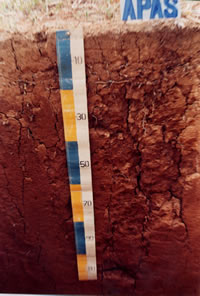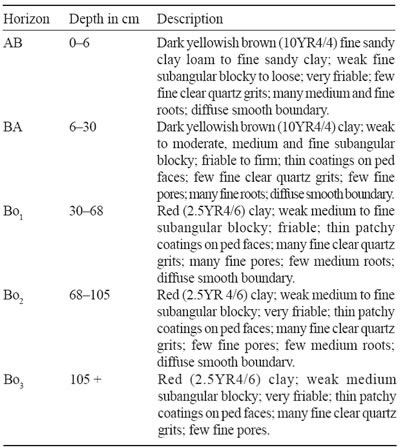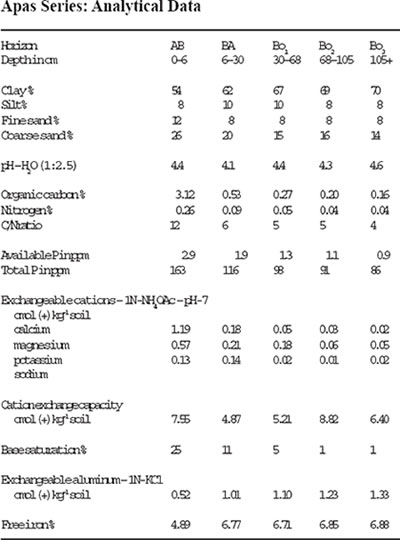Soil Profiles: Apas
Apas Series
The Apas Series is a member of the Apas Family which is a very fine, oxidic, isohyperthermic, red Tipik Tempalemoks. It typifies this family and is developed over andesites. Soils of the Apas Series are characterized by their deep well drained heavy clay textured oxic horizons which have an ECEC of more than 1.5 cmol (+) kg–1 clay. These soils are red or yellowish red in colour in the subsoils. Structures are moderate to weak, fine, subangular blocky and consistence is friable.
Type Location
Soils of the Apas Series were first established by Paton (1963) during the reconnaissance soil survey of the Semporna Peninsula. The above pedon was described by Paramananthan (1997) for the Soil Familiarisation and Soil Management Tour 2/1997 Tawau-Semporna, Sabah. The pedon was located under oil palm on rolling terrain at an elevation of 150 m (450 feet) in Ladang Sungei Kawa along the Tawau-Quoin Hill road. Location: Topographic Sheet 4/118/9, 4°23’15” N, 118°01’50” E (Grid Reference 4/118/9 – 919843 m).
Range in Characteristics
Little is known about the range in characteristics of the Apas Series. The soils are almost always deep with colours ranging from yellowish red to red within 50 cm of the soil surface. Field textures are uniformly clayey with more than 60% clay. However poor dispersion sometimes gives high silt values in the analysis results. Structures are weak to moderate medium subangular blocky and consistence is friable. The ECEC must be more than 1.5 cmol (+) kg–1 clay. It must be pointed out that those soils mapped in the past as Apas Series with an ECEC of less than 1.5 cmol should be now reclassified as the Segamat Series.
Competing Soils and Their Differences
Many soils have the red colours similar to that of the Apas Series. Soils having both a red colour, heavy clay texture and an oxic horizon include soils such as the Segamat, Prang and Kampong Kalam Series. These soils have an ECEC of less than 1.5 cmol (+) kg–1 clay. Other red soils with an oxic horizon include the Tarat/deep, Sagu and Patang Series which all belong to the Apas Family. These soils have an ECEC of more than 1.5 cmol (+) kg–1 clay and are differentiated by the parent material from which they are formed. The Apas (moderately deep soil), Tarat and Jebong Series (moderately deep soil) are all developed over andesites and could possible be correlated to form just one soil series after more work is done. The Sagu Series is developed over limestone while the Patang Series over hornfels (metamorphic rocks).
Setting
Soils of the Apas Series typically occur on undulating, rolling to hilly terrain (4– 38% or 2–20° slopes) at elevation of less than 200 metres (< 660 feet).
Principal Associated Soils
The Apas Series has often been mapped together with other soils developed over fine grained intermediate and basic igneous rocks such as andesites and basalts. As redefined here soils of the Apas Series can be expected to be mapped in association with soils of the Segamat, Table Series and soils of the Kobovan and Beeston Series. In the existing maps the Apas Family included soils with an ECEC of more than and less than 1.5 cmol (+) kg–1 clay. The Apas Series as redefined here only includes soils with an ECEC of more than 1.5 cmol. Both the Kobovan and Beeston Series have an argillic/kandic horizon while the Table Series has brown colours.
Drainage and Permeability
Soils of the Apas Series are generally well to somewhat excessively drained with good permeability.
Use and Vegetation
Soils of the Apas Series have been planted with oil palm, rubber and cocoa but in some areas they remain under primary forest.
Distribution and Extent
The Apas Series has to-date been only mapped in the Sandakan and Tawau Residencies in Sabah. Their actual extent based on their redefinition here is not known but can be expected in areas mapped as Segamat in Peninsular Malaysia and as the Tarat Series in Sarawak.
Series Established
The Apas Series was established by Paton (1963) during the reconnaissance soil survey of the Semporna Peninsula. The source of name is the Apas River to the east of Tawau.
Remarks on Classification
The Apas Series as redefined here is classified according to the Malaysian Soil Taxonomy – Second Approximation (Paramananthan 1998) as a member of the very fine, oxidic, isohyperthermic, red family of Tipik Tempalemoks over fine grained intermediate and basic igneous rocks. They are classified here as soils having a deep, red oxic horizon which have heavy clay textures and an ECEC of more than 1.5 cmol (+) kg–1 clay. In the Keys to Soil Taxonomy – Eighth Edition (Soil Survey Staff 1998) this soil would probably be classified as a Typic Hapludox. In the FAO/UNESCO Soil Map of the World – Revised Legend (FAO 1990) the Apas Series would probably be classified as Haplic Ferralsols.
Suitability for Agriculture
The main limitation for agriculture in these soils is their generally low fertility status, high P fixation and their high permeability.



